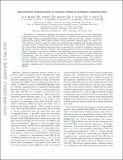Experimental demonstration of memory-enhanced quantum communication
Author(s)
Englund, Dirk R.
DownloadSubmitted version (5.092Mb)
Publisher Policy
Publisher Policy
Article is made available in accordance with the publisher's policy and may be subject to US copyright law. Please refer to the publisher's site for terms of use.
Terms of use
Metadata
Show full item recordAbstract
The ability to communicate quantum information over long distances is of central importance in quantum science and engineering. Although some applications of quantum communication such as secure quantum key distribution are already being successfully deployed, their range is currently limited by photon losses and cannot be extended using straightforward measure-and-repeat strategies without compromising unconditional security. Alternatively, quantum repeaters, which utilize intermediate quantum memory nodes and error correction techniques, can extend the range of quantum channels. However, their implementation remains an outstanding challenge, requiring a combination of efficient and high-fidelity quantum memories, gate operations, and measurements. Here we use a single solid-state spin memory integrated in a nanophotonic diamond resonator to implement asynchronous photonic Bell-state measurements, which are a key component of quantum repeaters. In a proof-of-principle experiment, we demonstrate high-fidelity operation that effectively enables quantum communication at a rate that surpasses the ideal loss-equivalent direct-transmission method while operating at megahertz clock speeds. These results represent a crucial step towards practical quantum repeaters and large-scale quantum networks.
Date issued
2020-03Department
Massachusetts Institute of Technology. Department of Electrical Engineering and Computer Science; Massachusetts Institute of Technology. Research Laboratory of ElectronicsJournal
Nature
Publisher
Springer Science and Business Media LLC
Citation
Bhaskar, M. K. et al. “Experimental demonstration of memory-enhanced quantum communication.” Nature 580, 7801 (March 2020): 60-64 © 2020 The Author(s)
Version: Original manuscript
ISSN
0028-0836